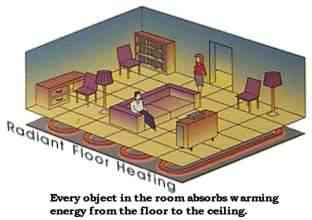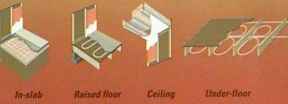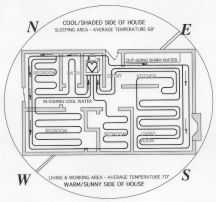|
|
|
|
|
|
Additional Resources: Forced Air vs. Radiant Heat

Radiant Heating is widely regarded as the most comfortable, healthiest, and most natural heating process available. People are warmed in the same way as they are warmed by sunshine on a cool day. Floor drafts, cold spots, and dry air are eliminated. Low humidity, levels, dust, air contaminants (mold, fungi, bacterium and viruses), all problems associated with forced-air heating, are greatly reduced and in many cases non-existent in a home with a properly designed radiant heating system.
Radiant Heat is based in principle on the primary source of heat we know -- the warmth of the sun. Hot water radiant heat, like natural sunlight, warms you and the objects around you instead of the air you breathe as other heating systems do. Radiant Heat also assures gentle draft-free circulation in each room of the home.
Where Does Radiant Heat Belong? Almost any floor surface can be radiant. It can be installed into new concrete slabs on gravel grade, or to cap an existing floor. Depending on where you live, you can install it outdoors in order to melt ice and snow from driveways and walkways.


To understand how your home heating system must perform to keep you comfortable, you have to understand what makes you uncomfortable -- what makes your body feel cold or hot. Your body has its own heating system which helps sustain life. Marvelous though it is, the human heating system alone can't keep you comfortable. For while the body generates heat, it also loses heat. Body heat is given off in winter by radiation, convection, and in a minor way, evaporation. Let's examine these forms of body heat loss in more detail:
- RADIATION -- transfer of heat by direct rays from your body to cooler objects around you. Place your hand next to a block of ice and you'll feel a chill as rays of heat leave your hand. Similarly, cold walls and floors draw heat from your body.
- CONVECTION -- transfer of heat from your body caused by the movement of air around you. A fan cools you because the draft pulls heat from your body. Even warm air will chill you if it moves rapidly about you.
- EVAPORATION -- transfer of heat from your body caused by water drying on your skin, as when you step from the bath. This only plays a minor part in body heat loss.
Your surroundings affect the rate at which you give off body heat. When the body heat loss is stepped up too rapidly you feel cold; when it is slowed down too much you feel hot. But when body heat loss is properly balanced with the environment, you feel comfortable.
Indoors there are several things that can speed up your body's heat loss, making you feel cold. These are drafts, cold walls, and cold floors. Your body is sensitive to fluctuating conditions, such as alternating hold-cold cycles, variable temperatures from room to room, and uneven temperatures from floor to ceiling.
Thus, your home heating system should balance body heat loss by supplying the right amount of heat and especially the same type of heat your body loses -- radiant and convected heat. Also, it must prevent drafts, it must warm the floors and walls, and it must provide steady, even heating throughout your home.

Water holds heat longer than any other heating system type and supplies steady uniform warmth. For example, a cubic foot of water at 100° F has 2500 times the heat capacity of a cubic foot of air. As a result, a small pipe does the same job as that would require a large duct using air.

Note: Each installation should be custom
engineered. Properly engineered radiant heat
systems compensate for orientation of the house.
Pictured to the right is a typical example.
Though skilled engineering and design are essential
to good performance, the radiant heating system is basically simple. It consists of the boiler and circulating pump -- the heart of the system, and the panel distribution tubing -- the arteries and veins. These work just like the human heating system. The "heart" (or boiler) warms a fluid, in this case, water, and pumps it out through the "arteries, (or tubes) and returns is out through the "veins" (return tubing) to be rewarmed.

FINANCIAL WELFARE -- Radiant heat cost less per unit of heat than any other type of heating. Conventional systems allow the heat to collect where its most likely to escape -- at the ceiling and along the walls. Because the temperature with radiant heat in each room remains relatively constant, heat loss can be reduced by up to 25%. Whether your house is traditional, or modern in design with large glass areas, radiant heat is the most economical method for heating every foot of your home because it can reduce the home energy needs up to 50% over conventional heating systems when properly designed and installed. Operating temperatures are so moderate that the tested, sturdy equipment lasts almost indefinitely. Thus, a house heated with radiant heat, retains its resale value.
HEALTH AND COMFORT -- Radiant heat means silent, draftless, controlled heat in every part of your house. It means the end to chilly areas, the floors are warm for playing children, and you can say good-bye to icy toes and "dull-headache fumes". No irritating dust is blown through the air by a radiant heat system. Correctly designed and engineered, radiant heat will eliminate damp, musty closets, and moisture condensation on walls and windows more successfully than any other heating system.
SAFETY -- Radiant heat reduces the dangers of gas and fire. There are no hazardous open grilles, dangerous burners, or hot radiators. Your children, guests, pets, furniture and rugs are safe from harm, because no direct physical contact with your radiant heating system is possible.
SMART, UP-TO-DATE APPEARANCE -- Radiant heat of the type discussed here is completely invisible. No slotted baseboards, moldings, panels, or other visible equipment. The smart appearance of your house cannot be spoiled by worn-out, dated heating equipment. Decoration can be planned with complete freedom. Furniture arrangement can ignore the heating system -- a big advantage when living space is so precious. Radiant heat is clean: draperies and painted surfaces stay bright and fresh because radiant heat carries no grimy fumes and dust to soil them. With systems that heat the air, cold surfaces such as walls and floors attract grime and dust more readily.
In fact, consumer surveys reveal that radiant heat is replacing older types of heating so rapidly that the house which does not offer its comfort and modern convenience may soon be seriously outdated. Within the next 10 years, it has been estimated that 40% of all new homes built will be heated by radiant heat. Click to compare Forced-Air systems with Radiant Heating systems.
ANDERSON RADIANT HEATING
520 East McGlincy Lane, Suite 16
Campbell, CA 95008
Phone: (408) 378-3868
Fax: (408) 559-0818
© Copyright 2012 - ANDERSON RADIANT HEATING
Privacy Policy
|
|
|
|